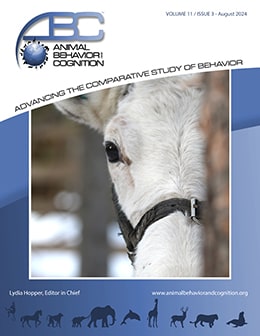Vol 11, Issue 3, August 2024
Withdraw-to-Eat Movements of the Platyrrhine Sapajus libidinosus to the Changing Affordance of Tubers with Eating
Citation
Whishaw, I. Q., Mirza Agha, B., Marino, L. A., Izar, P., Truppa, V. (2024). Withdraw-to-eat movements of the Platyrrhine Sapajus libidinosus to the changing affordance of tubers with eating. Animal Behavior and Cognition, 11(3), 270-292. https://doi.org/10.26451/abc.11.03.03.2024
Abstract
The evolution of hand ability in primates is staged, with the visual control of hand shaping likely originating in Platyrrhine primates, members of a monophyletic primate suborder whose stem group diverged from catarrhines about 40 million years ago. Platyrrhine hand shaping may have evolved in relation to visually mediated inhand food manipulation and hand withdraw to the mouth for eating movements. The present study examines this hypothesis in the Platyrrhine Sapajus libidinosus, the bearded capuchin monkey. These monkeys include the tuber raiz de macaco, or monkey’s root, in their diet, a food item that poses challenges in handling, peeling and eating. Analysis of video recordings show that the capuchins used vision to render the tuber into fibers and roots that could be chewed and ingested. Visual engagement was initiated as each rendering/eating sequence began and visual disengage, with a blink and head raise, occurred just before a tuber reached the mouth. Two-handed withdraws mainly brought intact tubers to the incisors for peeling and shredding and one-handed withdraws mainly brought tuber fibers and roots that protrude from the hand to the premolars for chewing. The capuchins made use of novel power hand grasps, featuring the digit tips pressing food items against the interdigit pads and palm. They displayed individual but not group preference in pulling and holding the tubers with one hand and manipulating the tuber at the mouth with the other hand. The results are discussed in relation to the idea that the evolution of the visual and cognitive skills associated with inhand food handling to the changing affordance of food facilitates its management by the mouth. This visuomanual skill could be applied to other functions including tool use.
Keywords
Gaze with hand withdraw, Gaze for eating in Sapajus, Gaze for food eating by Sapajus, Sapajus eating, Tuber eating by Sapajus, Hand use by Sapajus
